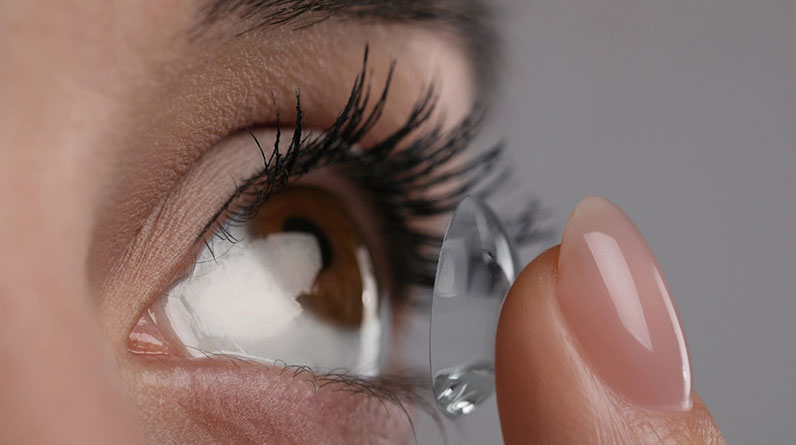
Proper Use of Contact Lenses
Contact lenses have become a popular choice for millions of people around the world who need vision correction but prefer an alternative to glasses.
Contact lenses offer a flexible solution for daily wear or specific activities, whether for convenience, aesthetics, or enhanced peripheral vision. However, proper care and handling of contact lenses are crucial to maintaining eye health and preventing complications such as infections or eye irritation.
There are four main types of contact lenses:
- Soft lenses
- Rigid gas permeable lenses (RGP)
- Extended wear lenses
- Disposable lenses
In what follows, we’ll explore the best practices for contact lens wearers to ensure safe and comfortable use while protecting their eyes from potential risks.
Daily Care and Maintenance
Proper daily care and maintenance are essential to ensure the longevity of contact lenses and the health of your eyes. Following best practices in cleaning, handling, and adhering to a wearing schedule can help prevent infections and other complications.
1. Cleaning and Disinfecting Lenses
Cleaning and disinfecting contact lenses is critical for removing debris, protein buildup, and bacteria that accumulate on the lenses throughout the day. Use only the cleaning solutions recommended by your eye care provider, and never use tap water or saliva to clean your lenses, as these can introduce harmful microorganisms.
Rubbing the lenses gently with your fingertips, followed by rinsing with solution, ensures that they’re thoroughly cleaned before being stored in a clean case filled with fresh disinfecting solution. Always replace the cleaning solution after each use, and avoid reusing old solution to prevent bacterial growth.
2. Handling Lenses
Proper handling of contact lenses is key to maintaining their cleanliness and ensuring safe insertion and removal. Before touching your lenses, always wash your hands with soap and water and dry them with a lint-free towel to avoid transferring oils, dirt, or fibers to your lenses.
When inserting or removing lenses, handle them gently to avoid tearing or damaging them. If a lens becomes damaged, discard it immediately and use a new one. It’s also important to avoid wearing contact lenses longer than the prescribed duration to prevent discomfort and reduce the risk of infection.
3. Wearing Schedule
Adhering to your recommended wearing schedule is crucial for keeping your eyes healthy. Contact lenses are designed for different wear durations, such as daily, bi-weekly, or monthly use, and should be replaced according to these guidelines.
Wearing lenses beyond their intended use can lead to protein deposits, dryness, and reduced oxygen flow to the cornea, increasing the risk of infections like keratitis or conjunctivitis.
Additionally, give your eyes a break by taking your lenses out before sleeping (unless you are using extended-wear lenses) to allow the cornea to get the oxygen it needs to stay healthy.
Prevention of Complications
Proper contact lens care is essential to avoiding serious eye infections and complications. By recognizing early signs of infection, reducing risk factors, and maintaining regular eye check-ups, contact lens wearers can protect their eyes and enjoy safe, comfortable use.
1. Recognizing Signs of Infection
One of the most important aspects of preventing serious eye issues is being able to recognize the early signs of infection. Symptoms of an eye infection may include redness, unusual discomfort, excessive tearing, blurred vision, sensitivity to light, or discharge from the eye.
If you experience any of these symptoms, it’s important to remove your contact lenses immediately and consult an eye care professional. Ignoring these signs or continuing to wear contact lenses despite discomfort can lead to more severe infections, such as corneal ulcers or even vision loss.
2. Reducing Risk Factors
Reducing the risk of infections starts with good hygiene and responsible lens care. Always wash your hands thoroughly before handling your lenses, avoid touching your eyes with unclean hands, and never sleep with lenses unless they are designed for overnight wear.
Swimming or showering with contact lenses should also be avoided, as water can introduce harmful bacteria into the eyes. Additionally, make sure to regularly clean and replace your contact lens case, as dirty cases are a common source of contamination. By following these guidelines, you minimize the chances of introducing bacteria or debris to your lenses and eyes.
3. Regular Eye Check-ups
Scheduling regular eye check-ups with your optometrist or ophthalmologist is crucial for maintaining eye health, especially if you wear contact lenses. During these visits, your eye care provider can assess the overall health of your eyes, ensure your lenses fit properly, and detect any early signs of infection or other complications.
Regular exams also give you the opportunity to discuss any discomfort or vision changes with your eye doctor, who can adjust your prescription or lens type if necessary. For contact lens wearers, yearly exams are typically recommended, but more frequent visits may be necessary if you have underlying eye conditions or experience recurring issues.
By recognizing infection symptoms early, reducing risk factors through proper care, and staying up-to-date with eye exams, you can prevent many of the complications that come with contact lens wear. These precautions not only keep your eyes healthy but also ensure your lenses remain comfortable and safe to use.
